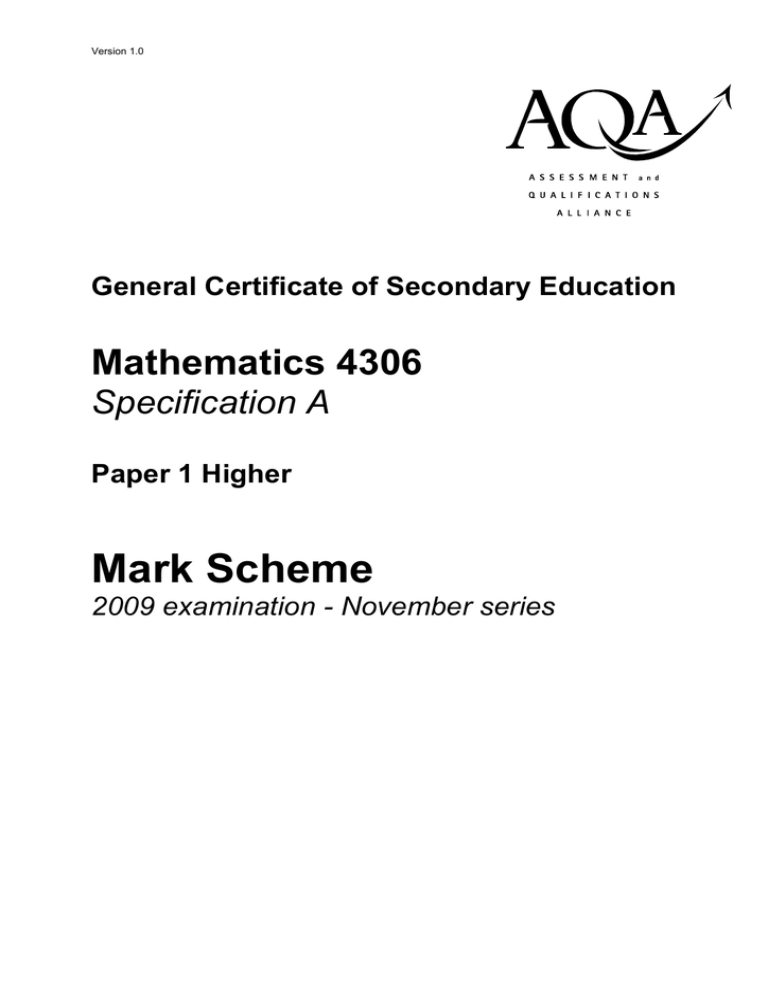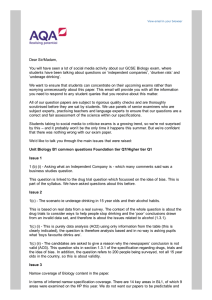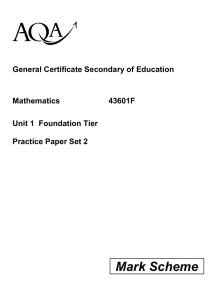
Version 1.0
General Certificate of Secondary Education
Mathematics 4306
Specification A
Paper 1 Higher
Mark Scheme
2009 examination - November series
Mark schemes are prepared by the Principal Examiner and considered, together with the
relevant questions, by a panel of subject teachers. This mark scheme includes any
amendments made at the standardisation meeting attended by all examiners and is the scheme
which was used by them in this examination. The standardisation meeting ensures that the
mark scheme covers the candidates’ responses to questions and that every examiner
understands and applies it in the same correct way. As preparation for the standardisation
meeting each examiner analyses a number of candidates’ scripts: alternative answers not
already covered by the mark scheme are discussed at the meeting and legislated for. If, after
this meeting, examiners encounter unusual answers which have not been discussed at the
meeting they are required to refer these to the Principal Examiner.
It must be stressed that a mark scheme is a working document, in many cases further
developed and expanded on the basis of candidates’ reactions to a particular paper.
Assumptions about future mark schemes on the basis of one year’s document should be
avoided; whilst the guiding principles of assessment remain constant, details will change,
depending on the content of a particular examination paper.
Further copies of this Mark Scheme are available to download from the AQA Website: www.aqa.org.uk
Copyright © 2009 AQA and its licensors. All rights reserved.
COPYRIGHT
AQA retains the copyright on all its publications. However, registered centres for AQA are permitted to copy material
from this booklet for their own internal use, with the following important exception: AQA cannot give permission to
centres to photocopy any material that is acknowledged to a third party even for internal use within the centre.
Set and published by the Assessment and Qualifications Alliance.
The Assessment and Qualifications Alliance (AQA) is a company limited by guarantee registered in England and Wales (company number 3644723) and a registered charity (registered charity number 1073334).
Registered address: AQA, Devas Street, Manchester M15 6EX
Dr Michael Cresswell Director General
Mathematics - AQA GCSE Mark Scheme 2009 November series
Glossary for Mark Schemes
GCSE examinations are marked in such a way as to award positive achievement wherever possible. Thus,
for GCSE Mathematics papers, marks are awarded under various categories.
M
Method marks are awarded for a correct method which could lead to a
correct answer.
A
Accuracy marks are awarded when following on from a correct method.
It is not necessary to always see the method. This can be implied.
B
Marks awarded independent of method.
M dep
A method mark dependent on a previous method mark being awarded.
B dep
A mark that can only be awarded if a previous independent mark has
been awarded.
ft
Follow through marks. Marks awarded following a mistake in an earlier
step.
SC
Special case. Marks awarded within the scheme for a common
misinterpretation which has some mathematical worth.
oe
Or equivalent. Accept answers that are equivalent.
eg, accept 0.5 as well as
1
2
3
Mathematics - AQA GCSE Mark Scheme 2009 November series
Q
Answers
Mark
Comments
1
450 and 15 and 90
B3
B2 for any two of 450, 15 and 90
B1 for any one of 450, 15 and 90
or for sight of 3/4 oe
or for 3/2 (or 2/3) (T) or 1/20 (or 20) (M)
or 3/10 (or 10/3) (C)
2
-2(3 × 3 + 1) or better
M1
eg. -2 (9 + 1) or -2 10 or (-2 9) + (-2 1)
-20 or -2 × 2 or -18 + -2
5
5
3
-4
A1
SC2 for 4
200 - 110 (boys)
M1
or
M1
or 100 – their 55
Their 90
4(a)
4(b)
5(a)
5(b)
6(a)
6(b)
7
M1dep
/200 100 or their 90 2
/200 100 or 110 2 or 55
110
45
A1
Sight of x + 125 or x + 1.25
M1
3(x + 125) (= 8x)
A1
oe
375 = 5x or 375 = 8x – 3x
M1
75
A1
Allow marks for solution done in (a) unless there is a
contradiction in (b)
48
76 17 93
95
in correct cells
For how long do you use the
treadmill?
Boxes to cover all possibilities
B2 for 3 or 4 correct
B1 for 1 or 2 correct
Look for any answers clearly stated in the working
oe Must be a time related question
not eg. ‘how many times used’
At least 3 boxes including 0
Must not overlap, no gaps
B3
B1
There must be a reference to
minutes or hours in either the
question or the response section
B1
Correct reflection
B2
B1 for reflection in x = 1 or x-axis or y-axis
B3
B2 for 90 rotation clockwise about any point other than
O
B2 for 90 rotation anticlockwise about O
B1 for 90 rotation anticlockwise about any point other
than O
SC2 for their B correctly rotated
Correct rotation
Graphical method
Algebraic method
x–3=2
M1
correct graph of y = x – 3
B1
x=5
A1
correct graph of y = 2
B1
(5, 2)
B1 ft if M1 earned
(5, 2)
B1
SC1 for y coordinate of 2 seen
4
Mathematics - AQA GCSE Mark Scheme 2009 November series
8
Sight of use of 8 for dotted length
Alt Top triangle area
= 1/2 × their 8 × 6 (= 24)
Lower rectangle area = 11 × 4
(= 44)
Alt
Area ‘surrounding’ rectangle
= 11 × 10 (= 110)
Area ‘missing’ trapezium
= 1/2 (11 + 3) 6 (= 42)
9
10(a)(i)
B1
M1
Area RH rectangle = 4 × 3 (= 12)
M1
Sight of use of 8 for dotted length
Alt Area LH scalene ∆
= 1/2 10 × their 8 (= 40)
M1
M1
68
A1
cm2
B1
Area RH trap = /2 (11 + 3) 4 (= 28)
1
A1
48
B1
M1
oe
E2
10(b)
Not enough trials
E1
oe
11(a)
2x + x + 90 = 180
M1
oe
30
A1
Angle CAD = (their)30
M1
[180 – (their)30] 2
M1
75
A1
11(b)
M1
Allow 1194 or 398 × 6 or 796 × 3
0.5
Allow 2388
ft for A1 for correct division
by 0.5 if first M1 earned
M1
Yes and …
either
Four correct theoretical values for
the colours red = 100 green = 50
blue = 25 yellow =
25
or
Correctly comparing all of the
relative frequencies with the
theoretical probabilities
or
Correctly comparing the ratios of
all the colours, both experimental
and theoretical
10
(a)(ii)
B1
M1
2400
/200
Alt Area LH trap = 1/2 (10 + 4) their 8 (= 56)
M1
Their 110 – their 42
Any two of 400 or 3 or 0.5
seen
1200 or 400 6 or 800 3
0.5
Sight of use of 8 for dotted length
E1 for Yes and …
either
One of the correct theoretical values for the colours
or
One correct relative frequency/theoretical probability
comparison
or
Correctly comparing the ratios of two colours, both
experimental and theoretical
Look for angles marked on the diagram
5
Mathematics - AQA GCSE Mark Scheme 2009 November series
12(a)
n2 + n + n + 1 or n2 – n – n + 1
M1
n2 + 2n + 1 + n2 - 2n + 1
A1
Convincing algebra to get 2n2 + 2
A1
2
12(b)
13
15
/8 () 12/5
/40 or
Answer given, must show cancelling of terms clearly
2
2n + 2 = 2(n + 1)
2 anything must be even
or 2 n2 is even, 2 is even,
even + even = even
180
3 out of 4 terms correct for either expansion
3
/2 × 3/1
41/2 or 9/2
Alternatively … E2 + E2 = EE + EE = E + E = E
… or …
O2 + O2 = OO + OO = O + O = E
E2
E1 for partial explanation
M1
Allow one error in numerators
A1ft
oe
ft their improper fractions if M1 earned
A1
alternatively
1.875 × 2.4
M1
Allow one error
1875
× __24
7500
37500
45000
Evidence of long multiplication
M1
4.5(000)
A1
Length None of these
Volume
B3
15(a)
5m - p
B1
15(b)
52p
B1
oe
3x - 2y = 9
3x + 12y = 30
M1
Allow error in one term
14y = 21
M1
Correct elimination from their equations
A1
SC1 correct answers with no working or using T&I
3(10 – 4y) – 2y = 9
M1
oe
14y = 21
M1
Correct simplification from their equation
x = 4 and y = 11/2
A1
14
16
6x - 4y = 18
x + 4y = 10
7x = 28
x = 4 and y = 11/2
B1 for each
eg. 52 p 5p + p
alternatively
17
D: 2x + 5y = 10
= 10
A: 5y + 10 = 2x
= 5x
Rearrange and substitute … allow one error
B: 5x + 2y
C: 2y + 10
B2 if two correct or three correct
B1 if 1 correct
B3
6
Mathematics - AQA GCSE Mark Scheme 2009 November series
18(a)
Two or three correct pairs of
angles
Angle BAC = Angle DEC
Angle ABC = Angle EDC
Angle ACB = Angle ECD
Two or three correct reasons
‘alternate’ for BAC and DEC
‘alternate’ for ABC and EDC
‘(vertically) opposite’ for ACB and
B1 for one correct pair of angles
B2
Look for angles marked on the diagram
B1
ECD
18(b)
DC
/20 = 6/8 or
DC
/6 = 20/8
6 20
8
19
15
A1
BD
M1
/18 = 8/BD
21(b)
Accept cos x = ? and tan y = 8
18
?
A1
y(x – 2) = w + x
M1
yx – 2y = w + x
M1dep
A1
Attempt at 7.00(0…) 11
M1
Sight of 63/99 scores M1
0.6363(6…)
A1
4 d.p. minimum
x = 0.3939…
100x = 39.3939…
M1
100x – x = 39.3939… – 0.3939…
M1
oe
x = 39/99 (= 13/33)
A1
SC1 for 0.3939… = 39/99 (= 13/33)
/33 = 7/11
13
13
/(7 3)
M1
( /33 =) 0.6363… /21
= 0.0303… 13
M1
(13/33 =) 0.3939…
A1
13
for M1
-2y – w = x – xy or -2y – w = x(1 – y)
… for rearranging/factorising
x = -2y – w must have x = … (A0 if not)
1–y
M1dep
alternatively
21(b)
oe
M1dep
12
xy – x = w + 2y
or x(y – 1) = w + 2y
x = w + 2y
y–1
21(a)
6 2.5 or 6 0.4 or 6 × their (20/8 )
or 6 ÷ their (2/5)
M1dep
BD2 = 18 8 (= 144)
20
Identifying scale factor of 2.5 (20/8 ) or 0.4 (2/5 ) oe
M1
13
7
Mathematics - AQA GCSE Mark Scheme 2009 November series
22(a)
22(b)
2nd bar drawn at height of 1.5
B1
3rd number = 100
B1
Answer in region 110 < T < 120
M1
20
23
/50 of 20 or sight of 8
or 30/50 of 20 or sight of 12
or 100 small squares = 20 vehicles
M1
112
A1
Sight of a correct product 7/10
6
/9
or 7/10 3/9 or 3/10 7/9 or 3/10
2
/9
M1
/10 3/9 + 3/10 7/9 + 3/10 2/9
M1
1 - 7/10 6/9
A1
oe
7
48
/90 or
24
24
/45 or
16
/30 or 8/15
y 1/x or y = k/x or 9 = k/8
M1
k = 72 or y = 72/x
A1
z y or z = cy or 20 = c
16
M1
c = 5 or z = 5y
A1
(when x = 2) y = 36
M1dep
(when y = 36) z = 30
A1ft
oe
for example, if drawn on 1cm2 grid,
4 cm2 = 20 vehicles or 1cm2 = 5 vehicles
ft their value of k … dependent on 1st M1
ft
their value of c and (their) y = 36
if first two M1 marks earned
SC1 for x 1/z2
25
(s =) 20
B1
(area ABC =) (20 2 8 10)
M1
3200
A1
/2 10 h = their 3200
or 402 seen
h = their √3200 or 40√2
5
5
Allow their 20 if from s = a + b + c
2
oe
1
(h =) 82
oe
Dependent on 1st M1 and s > 18
M1dep
Dependent on 2nd M1
M1dep
A1
alternatively
cos C = (10²+12²-18²) / (21012)
M1
cos C = - 1/3
A1
CD = 4
A1
(h² =) 12² - 4²
M1
(h =) 128
M1dep
(h =) 82
A1
Correct expression for cosine of obtuse angle C
D is (their) ‘foot of perpendicular’
8





